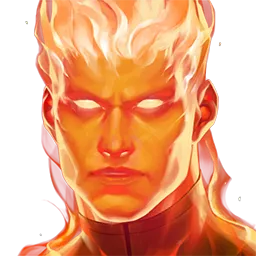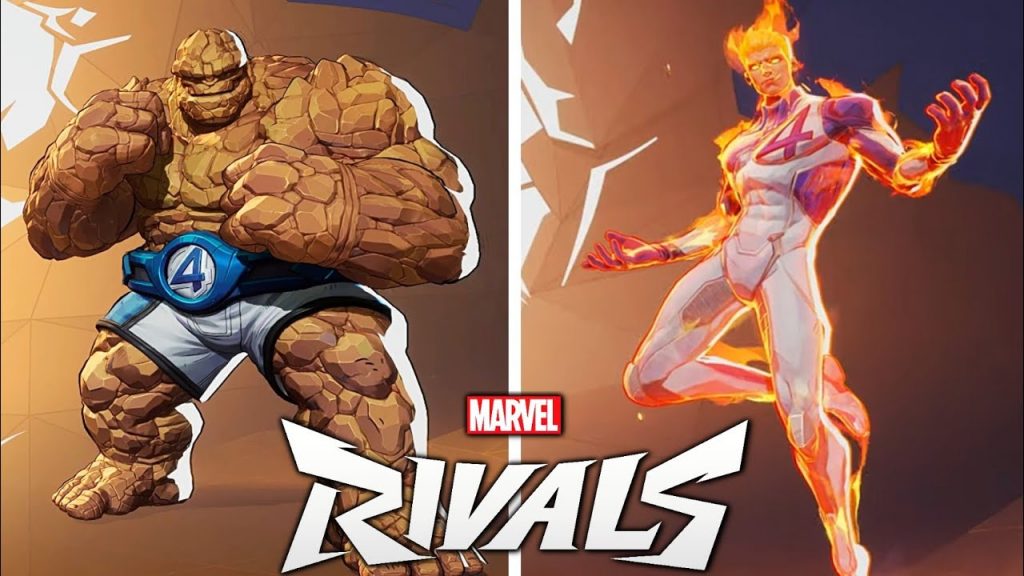Marvel Rivals has finally completed its Fantastic Four roster, bringing in Human Torch and The Thing. At the Blix team, we expected Human Torch to be a flashy glass cannon, zipping around the battlefield with high burst damage, while The Thing would be the textbook definition of a slow-moving tank. Instead, Marvel Rivals has introduced a dynamic aerial threat that thrives on battlefield control and a frontline bruiser built around disruption rather than just durability.
Their arrival shakes up team compositions and forces new strategies, but are they game-changers or just thematic additions? In this breakdown, we’ll analyze their abilities, strengths, weaknesses, ideal team setups, and pro-level tips to help you dominate with or against them.
Contents
Highlights
- Break-ups of Human Torch and The Thing
- Explanation of their abilities
- Description of playstyle with special hints
- Best team-ups explanation
- Additional: FAQ round-up of choosing those two.
Human Torch: The High-Flying Firestorm
Abilities & Playstyle
| Ability | Description |
| Passive – Blazing Soul | Allows indefinite flight as long as the heat meter isn’t empty. |
| Primary – Fire Cluster | Fires multiple small fireballs that explode on impact, dealing AoE damage. |
| Secondary – Blazing Blast | Creates a persistent fire zone that burns enemies over time. |
| Utility 1 – Plasma Body | Ascends rapidly, allowing for repositioning or escape. |
| Utility 2 – Pyro Prison | Links existing fire zones to create a flaming barrier, restricting movement. |
| Ultimate – Supernova | Enhances all active flame zones, turning them into swirling fire tornadoes. |
We expected a glass-cannon DPS with straightforward fire blasts, but Marvel Rivals gave us something closer to a high-mobility battlefield controller.
Passive – Blazing Soul
- Instead of a simple speed boost, Human Torch can fly indefinitely as long as his heat meter isn’t empty.
- Unlike heroes with limited aerial mobility (Magik’s teleport, Storm’s levitation), Torch can hover and reposition mid-fight, making him harder to hit but also a predictable target.
- Best Use: Avoid hovering too long, as snipers like Rocket Raccoon will punish predictable movement. Instead, use quick bursts of flight to stay mobile.
Primary Attack – Fire Cluster
- Fires multiple small fireballs that explode on impact, dealing consistent AoE damage rather than single-target burst.
- Unlike precision-based Duelists like Iron Fist, Human Torch focuses on sustained zone damage rather than raw dueling power.
- Best Use: Softens enemies before engagement—don’t rely on it for finishing blows.
Secondary Fire – Blazing Blast
- Instead of a short-range burst, it creates a persistent fire zone that forces enemies to move or take burn damage.
- Similar to Storm’s lightning fields, but lasts longer and is better for controlling choke points.
- Best Use: Drop this near health packs or chokepoints to punish enemies who try to escape.
Utility 1 – Plasma Body
- A vertical escape tool, unlike most horizontal dashes in the game (e.g., Captain America’s Charge).
- Counters melee characters like The Thing or Iron Fist by making them waste a movement ability while you reposition.
- Best Use: Don’t wait until you’re low HP—use it early to maintain control of the fight.
Utility 2 – Pyro Prison
- Links existing fire zones into a burning barrier, cutting off escape routes.
- One of the few persistent battlefield-control abilities in the game, similar to Magik’s portal traps but focused on area denial.
- Best Use: Don’t activate immediately—wait until an enemy is inside Blazing Blast to trap them in the fire.
Ultimate – Supernova
- Instead of a basic explosion, it enhances all fire zones, turning them into fire tornadoes that deal massive damage.
- Scales based on preparation—the more fire zones you set up before casting, the stronger it becomes.
- Best Use: Always set up at least one Blazing Blast before activating for maximum damage.
Pro Tips

- Don’t stay airborne too long. Enemies will adjust—descend strategically to avoid snipers.
- Use Pyro Prison to control movement. Block escape routes rather than trying to trap someone already running.
- Pair Blazing Blast with crowd control. It only works if enemies stay inside, so use it alongside heroes with stuns.
Best Team Compositions
Human Torch demands specific synergy with heroes who can either control enemy positioning or keep him alive while airborne.
- Storm (Strategist): Both create elemental zones—Storm’s lightning storms and Torch’s flame fields make escape impossible.
- Captain America (Vanguard): His shield-throws stun enemies in place, keeping them trapped inside Pyro Prison’s fire walls. His support skills also help Torch stay in the air longer.
- Magik (Duelist): Her portals allow Human Torch to relocate mid-flight, making him an unpredictable threat.
- Luna Snow (Strategist): Since Human Torch is vulnerable while flying, Luna’s global healing keeps him from dropping unexpectedly.
The Thing: The Unbreakable Bruiser
Abilities & Playstyle
| Ability | Description |
| Passive – Unyielding Will | Immune to knockbacks and displacement effects. |
| Primary – Rocky Jab | A series of rapid punches dealing sustained melee damage. |
| Secondary – Stone Haymaker | A charged punch that staggers enemies, interrupting abilities. |
| Utility 1 – Yancy Street Charge | Charges forward, launching enemies and preventing them from dashing. |
| Utility 2 – Embattled Leap | Jumps to an ally, granting both damage reduction. |
| Ultimate – Clobberin’ Time | Launches all enemies in front into the air, disrupting entire fights. |
We expected a simple, slow-moving tank but got a disruptive, gap-closing juggernaut instead.
Passive – Unyielding Will
- Unlike other tanks with shields or armor, The Thing simply cannot be knocked back or displaced.
- One of the best counters to knockback-heavy heroes like Thor and Storm.
- Best Use: Fight near ledges against displacement-based enemies—they’ll waste their abilities trying to move you.
Primary Attack – Rocky Jab
- A rapid melee sequence, not slow, heavy swings like Thor or Captain America.
- Makes him better in longer brawls, since he deals consistent DPS rather than single-hit burst.
- Best Use: Force enemies into extended fights rather than quick trades.
Secondary Fire – Stone Haymaker
- A charged punch that staggers enemies, interrupting abilities mid-cast.
- One of the few ways to cancel ultimates, making it a hard counter to slow-casting heroes like Human Torch, Magik, or Iron Man.
- Best Use: Time this against enemy ultimates rather than using it immediately for damage.

Utility 1 – Yancy Street Charge
- A full-force charge that launches enemies and prevents them from dashing afterward.
- Unique because most tank charges only displace enemies, but this one locks down mobile heroes like Iron Fist, Magik, or Black Panther.
- Best Use: Use this to engage against mobile enemies and shut down their escape options.
Utility 2 – Embattled Leap
- Instead of a self-sustain move, it’s a team-oriented leap that grants damage reduction to both The Thing and an ally.
- One of the best peel tools in the game, allowing him to rescue squishy teammates instead of just absorbing damage himself.
- Best Use: Save this for an ally under fire, not just as an engagement tool.
Ultimate – Clobberin’ Time
- Instead of a simple slam, this launches enemies into the air, making them vulnerable to follow-up attacks.
- One of the best crowd control ultimates in the game, countering heroes who lack aerial recovery.
- Best Use: Coordinate this with teammates to capitalize on the launch for an easy wipe.
Pro Tips

- Use Yancy Street Charge in tight spaces. Enemies cannot dodge it if the corridor is too narrow.
- Save Embattled Leap for rescuing allies. It is a great way to protect squishier teammates rather than just engaging.
- Time Stone Haymaker against enemy ultimates. If you land it before they cast, you cancel their entire attack.
Best Team Compositions
The Thing is not just a tank—he forces fights on his terms. He needs high-damage allies who can capitalize on his crowd control.
- Iron Fist (Duelist): The Thing’s staggering attacks make it easy for Iron Fist to land his combos, turning fights into 1v2 brawls in his favor.
- Thor (Vanguard): Since The Thing prevents enemies from escaping, Thor’s lightning strikes become unavoidable burst damage.
- Rocket Raccoon (Marksman): If The Thing locks someone down, Rocket’s high-damage explosives make quick work of them.
- Magik (Duelist): Portals let The Thing engage from unexpected angles, turning him into an ambush tank.
FAQ – Should You Play Human Torch or The Thing?
Who should play Human Torch?
- Players who like high-speed mobility and battlefield control.
- Those comfortable managing a resource-based flight system instead of unlimited aerial time.
- Players who enjoy area denial strategies over direct combat.
Who should play The Thing?
- Players who prefer tanking with aggressive disruption abilities.
- Those who like leading the charge and setting up fights rather than just absorbing damage.
- Anyone tired of getting knocked back or stunned—he simply ignores those effects.
Are they strong in the current meta?
- Human Torch has high potential but requires good positioning and timing—strong but not overpowered.
- The Thing is already a top-tier tank, especially against mobility-based heroes.
What are their biggest weaknesses?
- Human Torch struggles if enemies focus him while airborne or force him to land.
- Ranged heroes can kite the Thing if he fails to engage properly.
Who are the next heroes expected to join Marvel Rivals?
- While nothing is officially confirmed, leaks and datamining suggest several potential upcoming heroes.
- Characters like Blade, Ultron, Emma Frost, Jean Grey/Phoenix, and Deadpool have been mentioned in various reports.
- A recent map reveal trailer subtly showcased Blade, hinting at his future inclusion.
- Marvel Rivals follows a six-week release cycle for new heroes, so we can expect regular additions.
Important Note: These are leaks and not officially confirmed—plans can change, and new surprises may be in store. Stay tuned to official updates for verified announcements.



